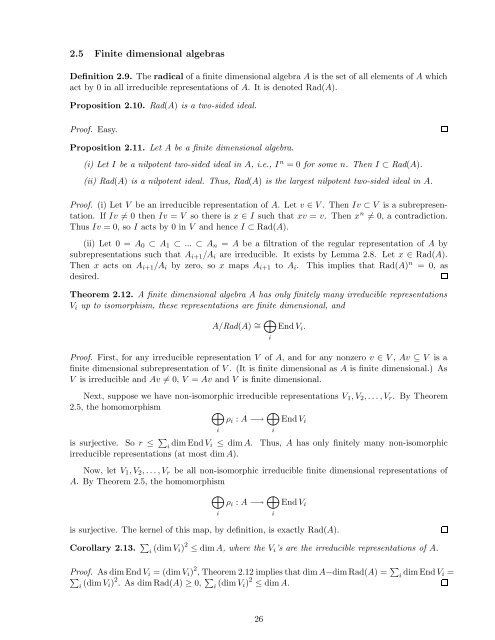Lecture notes for Introduction to Representation Theory
Lecture notes for Introduction to Representation Theory
Lecture notes for Introduction to Representation Theory
You also want an ePaper? Increase the reach of your titles
YUMPU automatically turns print PDFs into web optimized ePapers that Google loves.
⇒<br />
⇒<br />
2.5 Finite dimensional algebras<br />
Definition 2.9. The radical of a finite dimensional algebra A is the set of all elements of A which<br />
act by 0 in all irreducible representations of A. It is denoted Rad(A).<br />
Proposition 2.10. Rad(A) is a two-sided ideal.<br />
Proof. Easy.<br />
Proposition 2.11. Let A be a finite dimensional algebra.<br />
(i) Let I be a nilpotent two-sided ideal in A, i.e., I n = 0 <strong>for</strong> some n. Then I → Rad(A).<br />
(ii) Rad(A) is a nilpotent ideal. Thus, Rad(A) is the largest nilpotent two-sided ideal in A.<br />
Proof. (i) Let V be an irreducible representation of A. Let v V . Then Iv → V is a subrepresenn<br />
tation. If Iv = 0 then Iv = V so there is x I such that xv = v. Then x = 0, a contradiction.<br />
Thus Iv = 0, so I acts by 0 in V and hence I → Rad(A).<br />
(ii) Let 0 = A 0 → A 1 → ... → A n = A be a filtration of the regular representation of A by<br />
subrepresentations such that A i+1 /A i are irreducible. It exists by Lemma 2.8. Let x Rad(A).<br />
Then x acts on A i+1 /A i by zero, so x maps A i+1 <strong>to</strong> A i . This implies that Rad(A) n = 0, as<br />
desired.<br />
Theorem 2.12. A finite dimensional algebra A has only finitely many irreducible representations<br />
V i up <strong>to</strong> isomorphism, these representations are finite dimensional, and<br />
A/Rad(A) ∪ =<br />
End V i .<br />
Proof. First, <strong>for</strong> any irreducible representation V of A, and <strong>for</strong> any nonzero v V , Av ∧ V is a<br />
finite dimensional subrepresentation of V . (It is finite dimensional as A is finite dimensional.) As<br />
V is irreducible and Av = ⇒ 0, V = Av and V is finite dimensional.<br />
Next, suppose we have non-isomorphic irreducible representations V 1 , V 2 , . . . , V r . By Theorem<br />
2.5, the homomorphism <br />
δi : A −⊃ End V i<br />
i<br />
i<br />
is surjective. So r ∗ ⎨ i dim End V i ∗ dim A. Thus, A has only finitely many non-isomorphic<br />
irreducible representations (at most dim A).<br />
Now, let V 1 , V 2 , . . . , V r be all non-isomorphic irreducible finite dimensional representations of<br />
A. By Theorem 2.5, the homomorphism<br />
<br />
δi : A −⊃ End V i<br />
i<br />
i<br />
i<br />
is surjective. The kernel of this map, by definition, is exactly Rad(A).<br />
Corollary 2.13. ⎨ i (dim V i) 2 ∗ dim A, where the V i ’s are the irreducible representations of A.<br />
Proof. As dim End V i = (dim V i ) 2 , Theorem 2.12 implies that dim A−dim Rad(A) = ⎨ ⎨<br />
dim End V i =<br />
(dim Vi ) 2 . As dim Rad(A) ⊂ 0, ⎨ (dim V i ) 2 i<br />
∗ dim A.<br />
i<br />
i<br />
26

















